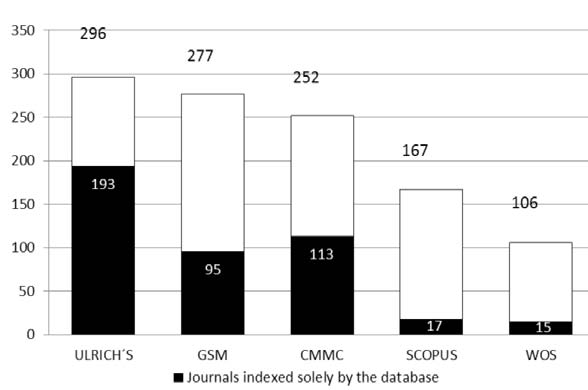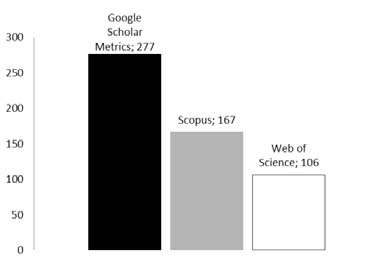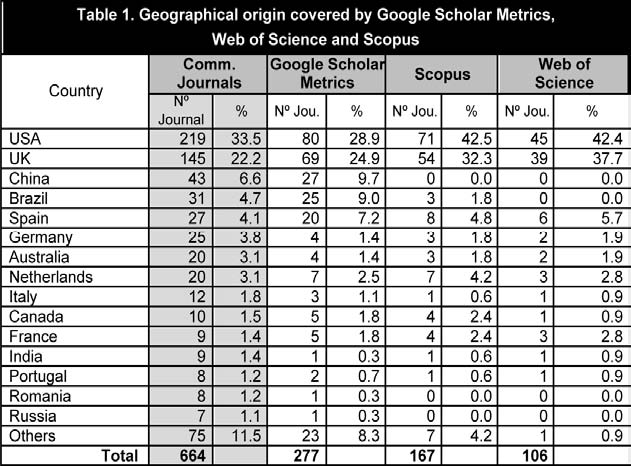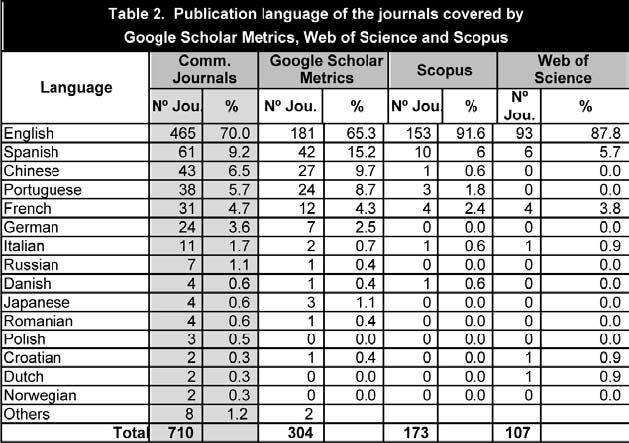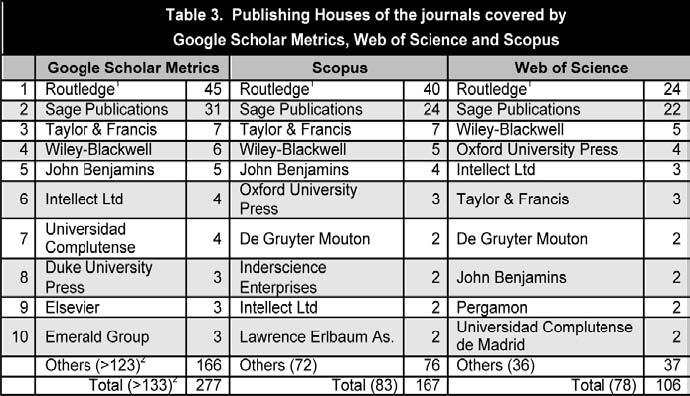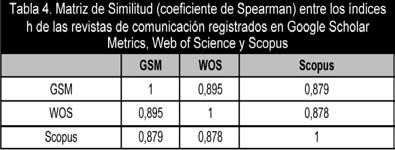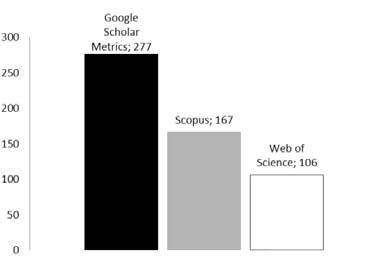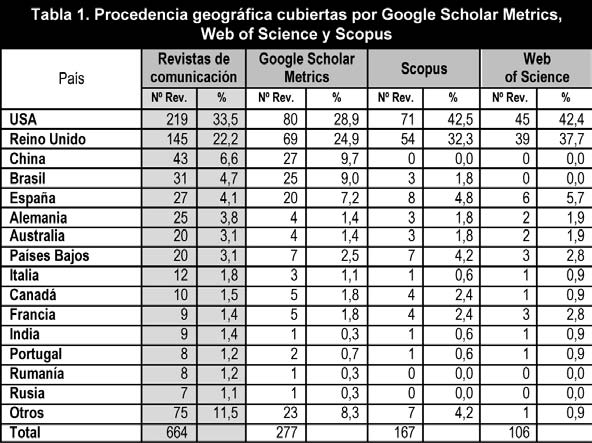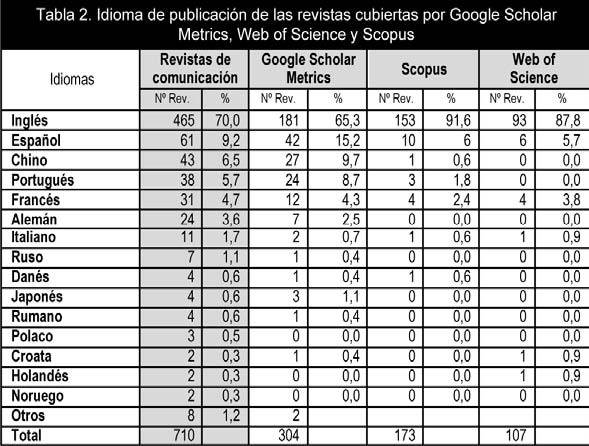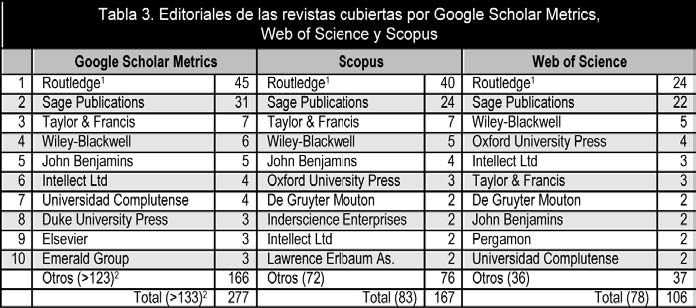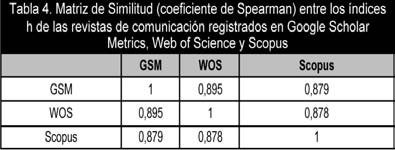Pulsa aquí para ver la versión en Español (ES)
Abstract
Google Scholar Metrics' launch in April 2012, a new bibliometric tool for the evaluation of scientific journals by means of citation counting, has ended with the duopoly exerted by the Web of Science and Scopus databases. This paper aims at comparing the coverage of these three databases and the similarity their journal rankings may have. We selected a sample of journals from the field of Communication Studies indexed in the three databases. Data was recollected on 1720 November, 2012. 277 journals were identified to which we calculated their hindex and ranked them according to such indicator. Then, we analyzed the correlation between the rankings generated. Google Scholar Metrics dobles the coverage of the other databases, reducing the bias toward English language both; web of Science and Scopus have. Google Scholar Metrics shows higher hindex values (an average 47% higher than Scopus and 40% higher than Web of Science), allowing to better rank journals. We conclude that Google Scholar Metrics is a tool capable of identifying the main journals in Communication Studies offering results as reliable and valid as the ones Web of Science and Scopus show.
1. Introduction
The launch of Google Scholar Metrics (GSM) in April 2012 was at first greeted with jubilation, given the novelty of its appearance as an original and singular tool for the evaluation of the impact of scientific journals. In addition, it brought healthy competition into the scientific information market, dominated until then by Thomson Reuters’ Web of Science (WOS) and Elsevier’s Scopus. This led to various analyses that have subjected the new product to critical assessment trials.(Delgado López-Cózar & Cabezas, 2012a; Delgado López-Cózar & Robinson, 2012; Jacsó, 2012). Amongst the numerous criticisms received, most notable were those directed at the unusual presentation of journal rankings by language, and not by scientific discipline, and the limitation of search results using key words from journal titles to only 20 documents. Aware of these criticisms, Google launched a new version in November 2012. Here Google opted for offering general rankings by language, but also by thematic area and discipline, although limiting this option only to journals in English, excluding the other nine languages in which Google offers lists of journals (Chinese, Portuguese, German, Spanish, French, Korean, Japanese, Dutch and Italian). Given the continued limit of only 20 documents in the results display, one of the main functions of journal rankings is made impossible: the comparison of the impact of journals belonging to a particular discipline or scientific speciality (Hodge & Lacasse, 2011).
Communication journals have been placed within the thematic area of Humanities, Literature and Arts, in two disciplines: Communication and Film. In each of these, only the 20 journals with the highest h index are shown. In order to overcome these two limitations, and using various search procedures, the first objective of this paper is to provide a ranking for all those communication journals indexed in GSM. There have been a number of papers on the impact of communication journals by citation analysis, though they have fundamentally centered on aspects such as establishing the scant coverage of the Thomson-Reuters databases (Stephen, 2008), the validity of the impact indices as an evaluation indicator (Houser, 2006), the national or international orientation of the journals (Lauf, 2005), patterns of citation (So, 1988) and the similarity of journals based on network analysis (Rice & al., 1988; Hakanen & Wolfram, 1995; Park & Leydesdorf, 2009). Only Levine’s study (2010) dealt with measuring the impact of communication journals through Google Scholar, indicating the differences with the ISI database, although it covered only 30 journals. Therefore, the subject of this present paper is unpublished. On the other hand, in order to trust a new bibliometric product in which the impact of journals is measured by citations, it is advisable to test this by comparison with the rankings offered by WOS or Scopus, these being the standard reference systems in the world of scientific evaluation. These products have traditionally been criticised for their English language bias. Archambault & Gagné (2004) demonstrated how journals from the United States and Great Britain were significantly over-represented in the WOS, a problem which is more acute in social sciences and humanities. For this reason, it is appropriate to investigate to what extent the new Google product is capable of eliminating this bias and offering considered, dependable and valid results (Cabezas & Delgado López-Cózar, 2012b; Delgado López-Cózar & al., 2012). Therefore, the second objective of this paper consists of demonstrating to what extent the journal rankings generated by GSM coincide or differ from those of WOS and Scopus in the field of communication.
2. Material and methods
This study refers to scientific journals that deal with the phenomenon of communication (theory, history and research), media (press, radio and television), journalism, audiovisual media, cinema, rhetoric and journalistic message, advertising and public relations. In order to identify communication journals, the following sources of information have been consulted:
• ULRICH’S International Directory, which is considered the largest and most up-to-date directory of periodic publications in the world. It retrieved all existing scientific journals (academic/scholarly) that had been indexed by topic in the categories («subjects»): «Communication», «Journalism», «Communication Television and Cable», «Communication Video», «Advertising» and «Public Relations».
• GSM: Two strategies were employed here: Firstly, any indexed journals in the Communication category were downloaded. It should be noted that they were curiously listed under «Humanities», «Literature & Arts» and not under «Social Sciences». Secondly, a series of searches in journal titles was undertaken using the following keywords: «Communication», «Mass Communications», «Communication Research», «Journalism», «Media», «Film», «Advertising», «Cinema, Audiovisual», «Audio», «Radio», «Television», «Public Relations», «Public Opinion», «Movie». These searches were carried out in the following languages: English, French, Spanish, German, Italian, Portuguese, Chinese, Japanese, Korean, Arabic, Russian, Turkish and Polish.
• Communication & Mass Media Complete: Communication journals considered as «core», that is, entered in the database in their entirety (cover to cover). (www.ebscohost.com/academic/communication-mass-media-complete).
• WOS: Journals indexed in the topical categories of «Communication» and «Film, Radio & Television» (http://ip-science.thomsonreuters.com/mjl).
• Scopus: Journals indexed in the topical categories of «Communication» and «Visual Arts and Performing Arts» (www.info.sciverse.com/scopus/scopus-in-detail/facts).
After a manual filter of the entries for each search, to identify the relevant journals for the subject area covered by this paper, all the information was downloaded into a Microsoft Access® database, where titles were unified and any duplicates eliminated.
A total of 664 communication journals were identified. These journals were then searched for in GSM in the last week of November 2012. 277 journals appearing in appendix 1 (http://bit.ly/X7HFBO) were found. These are ordered according to both the h index and the average number of citations obtained by the articles which contributed to the h index. The h index, which is the bibliometric indicator adopted by GSM to measure the impact of journals, was proposed by Jorge Hirsch in 2005 for use in measuring researcher performance but was immediately applied to journals (Braun & al., 2005). A journal has an index equal to h when h of its articles have received at least h citations each; that is, a journal with an h index of 22 is one which has published 22 articles with at least 22 citations for each of these articles. The h index has received substantial attention, leading to numerous studies, proposals of new indicators, and already has at least two bibliographical reviews (Alonso & al., 2009; Egghe, 2010).
In order to carry out the comparative study with WOS and Scopus, the 277 journals located in GSM were searched for in these databases. Searches were limited to the same period as that used by GSM (2007-2011). Therefore, this comparative analysis only applies to the journals that are well represented in GSM and WOS (N=63) and in GSM and Scopus (N=102). Spearman’s correlation coefficient (rho) was used, habitually employed in bibliometric studies in order to measure the grade of association between two variables according to their position in different rankings (Leydesdorf 2009; Bollen 2009; Torres-Salinas & al., 2010). The h indices of the journals offered by the three platforms were correlated according to the geographical origin of the publication, the language of the edition and the publishing house.
3. Results
3.1. Bibliographic control of communication journals
664 communication journals have been identified by this study (Figure 1). Ulrich’s, the directory specialised in the control of periodical publications, was the system that located the highest number of journals. This was closely followed by GSM, a surprising fact when taking into account the general and open nature of the tool. Communication & Mass Media Complete also came close, a logical occurrence for an international database specialised in communication journals. The two large multidisciplinary databases (Scopus and WOS) had significantly lower coverage. However, it is worth noting that Web of Science contains 15 journals not registered in the other databases.
What is truly unprecedented is the limited overlapping that exists between the databases. 65% of the journals (433) appear indexed in one database only (Figure 1); Ulrich’s being once again the product with the widest coverage. This means, that in order to carry out a thorough inventory of communication journals, it is necessary to turn to several information systems, which come to be complementary.
3.2. H Index of the communication journals in Google Scholar Metrics (2007-11)
Focusing on the primary objective of this paper, appendix 1 relates the communication journals ordered according to the h index provided by GSM for the period 2007-2011. As previously stated, there are 277 journals. As can be seen, GSM does not manage to cover half (41.7%) the sphere of communication journals circulating in the world. The strict criteria of inclusion adopted by GSM (journals with more than 100 published articles with at least one citation in the last 5 years), excludes a large number of publications unable to reach this threshold.
The values of the h indices obtained are not particularly low: 70% of the journals have an index equal to or greater than 5, with a maximum value of 43 and a minimum of 1. This allows a relatively reliable identification of the leading journals within the speciality, indicating pronounced differences between journals. The first quartile of the h index is dominated by journals of English language origin (United States and United Kingdom) and written in English. Only five journals are not edited in these countries and only one is published in a language other than English. It is necessary to move down to the last positions in the second quartile in order to find Chinese, Spanish, Brazilian, French or Portuguese journals; even then, they do not represent more than a third of the journals in this quartile.
3.3. Editorial composition of Google Scholar Metrics, Scopus and Web of Science.
The second objective of this paper is to compare GSM with WOS and Scopus, the traditional systems for the evaluation of the impact of journals by means of citation analysis. The main results obtained are set out below. From the point of view of size, GSM almost doubles (65.9%) the number of titles covered by Scopus and almost triples those indexed by WOS (figure 2).
When considering the geographical origin of the journals covered (table 1), GSM reduces the English language bias that has historically stigmatized both WOS and Scopus, representing in a more balanced manner the actual importance of the different nations publishing journals (table 1). A simple comparison of the distribution of the 664 journals by countries that constitute the sphere of communication journals identified in this study reveals how GSM is almost precisely adjusted to the volume of journal production in the world, as opposed to the completely biased distribution of WOS and Scopus. GSM not only indexes journals from more countries (30 GSM compared to 23 from Scopus and 13 from WOS), but also reduces the percentage of journals from the United States and the United Kingdom to 53.79%, compared to 74.85% from Scopus and 80.19% from WOS. Furthermore, it gives adequate room to countries with an undeniable weight in the production of journals, such as China and Brazil, whose journals do not even appear in WOS and only very nominally in Scopus.
If the publication language of the journals is analysed, a similar situation is found. GSM is better adjusted to the real use of different languages in existing communication journals throughout the world, eliminating the heavy English language bias of Scopus and WOS (table 2). So, whilst Scopus and WOS only register journals published in 7 different languages, GSM includes journals in 13 languages. English, the principal publication language for communication journals, has a very different prominence depending on the database. It represents 59.67% of GSM indexed journals (182) whilst in Scopus and WOS it reaches 88.66% and 86.92% respectively (172 and 93 journals). Spanish is placed as the second language in all of the databases but its percentage of representation varies between 5.15% in Scopus, 5.61% in WOS and 13.77% in GSM. It should be noted that, in GSM, Chinese and Portuguese are the third and fourth most used languages respectively (8.85% y 7.78%), whilst Scopus only registers one journal in Chinese (0.52%) and three in Portuguese (1.55%). WOS does not include either of these two languages (Table 2).
However, when the distribution of journals is studied according to their publishing houses, the same pattern is found for all three products (Table 3). The same six publishing houses in the three databases (Routledge y Sage, Taylor & Francis, Wiley-Blackwell, John Benjamins, Oxford University Press), in equal measure, publish the majority of the journals. Nevertheless, as occurred with language and country of publication, it is true that GSM is much more open to all types of publishing houses, having a lower concentration. Therefore, if the 10 most productive publishing houses represent 54.49% of the total in Scopus and 65% in WOS, this only reaches 40% for GSM.
3.4. Comparing journal rankings
Finally, from a bibliometric viewpoint, when a new product appears for evaluating the impact of scientific journals by means of citation analysis, it is most relevant to compare the extent to which the journal rankings given by GSM are similar or different to those given by WOS and Scopus. The comparative table of h indices of the journals in Google Scholar Metrics, WOS and Scopus has been uploaded to the following address http://bit.ly/YQZkZP.
Firstly, it can be confirmed that the average h index of the journals in the sample is 40% higher than that of WOS and 47% higher than that of Scopus. In some highly significant journals in the sphere of Communication («Public Opinion Quarterly», «Journal of Communication», «Telecommunications Policy», «Communication Research», «Public Relations Review») the GSM h indices are two or three times higher than the two other aforementioned databases. Secondly, a high similarity between the three rankings is observed, there being only slight differences as to which are the leading journals. The high level of correlation detected (0.895 for WOS and 0.879 for Scopus) shows this close similarity between rankings (Table 4). Naturally, this does not mean they are identical; for example, «Journalism Studies», which is the 17th journal according to GSM, falls to 27th place in WOS and 61st in Scopus.
4. Discussion and conclusions
The first conclusion that can be reached by this study is the difficulty of adequately identifying and locating the journals produced worldwide in the scientific field of communication. None of the databases used here are capable of exhaustively monitoring all of the existing journals, for which reason it is necessary to use all three databases together. Despite the problematic technique implied by this lack of bibliographic control, it is certain that a contributory factor is the multidisciplinary nature of Communication itself, having boundaries so vague as to prevent a clear delimitation of the field covered. Communication receives a substantial theoretical inheritance from many other fields, such as rhetoric, sociology, psychology and semiotics (Craig, 1999) and has undergone important fluctuations in its epistemological values. It has passed from rhetoric, discourse and the media of the masses, to centre on the new means of communication: public relations, advertising and human communication (Craig 2003; Chung & al, 2009).
Apart from this discovery, collateral to the objective of this paper, the main finding obtained is the more than ample coverage of GSM, not only for identifying communications journals but also its manifest utility as a tool for the evaluation of the scientific impact of scientific journals. It not only covers more journals than its competitors (WOS and Scopus) but also lacks their English language bias; registering journals originating from more countries and written in more languages. All this is achieved in spite of its restrictive indexing policy. These results confirm what has been suggested by previous empirical studies on Google Scholar (Bakkalbasi & al., 2006; Meho & Yank, 2007; Falagas & al., 2008; Bar-Ilan, 2008-2010; Kulkarni & al., 2009), which is the information source for generating the bibliometric data offered by GSM. Being built on Google Scholar, GSM is based on the most thorough and least biased academic and scientific data source currently in existence.
When the ranking of journals is compared with that offered by Scopus and WOS, it is confirmed that GSM offers greater indicators (almost double) and, most relevantly, a high correlation, something already demonstrated by other studies (Vanclay, 2008; Harzing & Wal, 2009; Delgado López-Cózar & al., 2012; Cabezas & Delgado López-Cózar, pending publication). Consequently, it can be affirmed that GSM measures journals in a very similar way to the classic journal evaluation systems (WOS and Scopus) for which, broadly speaking and for ranking only purposes, it is an equally reliable and valid alternative for measuring the impact of journals.
In short, this paper supplies the h index impact of 277 communication journals. Although this figure represents approximately less than half (41.7%) the sphere of communication journals circulating in the world, it includes those journals considered world leaders, which in addition occupy the top positions.
References
Alonso, S., Cabrerizo, F.J., Herrera-Viedma, E. & Herrera, F. (2009). H-Index: A Review focused in its Variants, Computation and Standardization for Different Scientific Fields. Journal of Informetrics, 3(4), 273-289. (http://dx.doi.org/10.1016/j.joi.2009.04.001).
Archambault, E. & Gagné, E.V. (2004). The Use of Bibliometrics in Social Sciences and Humanities. Montreal: Social Sciences and Humanities Research Council of Canada (SSHRCC).
Bakkalbasi, N., Bauer, K., Glover, J. & Wang, L. (2006). Three Options for Citation Tracking: Google Scholar, Scopus and Web of Science. Biomedical digital libraries, 3(7). (http://dx.doi.org/10.1186/1742-5581-3-7).
Bar-Ilan, J. (2008). Which h-index? A Comparison of WoS, Scopus and Google Scholar. Scientometrics, 74(2), 257–271. (http://dx.doi.org/10.1007/s11192-008-0216-y).
Bar-Ilan, J. (2010). Citations to the ‘Introduction to Informetrics’ Indexed by WOS, Scopus and Google Scholar. Scientometrics 82(3), 495–506. (http://dx.doi.org/-10.1007/s11192-010-0185-9).
Bollen, J., Van de Sompel, H., Hagberg, A. & Chute, R. (2009). A Principal Component Analysis of 39 Scientific Impact Measures. PloS one, 4(6), e6022. (http://dx.doi.org/-10.1371/journal.pone.0006022).
Braun, T., Glänzel, W. & Schubert, A. (2005). A Hirsch-type Index for Journals. The Sciencist, 19(22), 8-10.
Cabezas-Clavijo, Á. & Delgado López-Cózar, E. (2012a). ¿Es posible usar Google Scholar para evaluar a las revistas científicas nacionales en los ámbitos de Ciencias Sociales y Jurídicas? El caso de las revistas españolas. EC3 Working Paper, (3). (http://eprints.rclis.org/handle/10760/16888).
Cabezas-Clavijo, Á. & Delgado López-Cózar, E. (2012b). Las revistas españolas de Ciencias Sociales y Jurídicas en Google Scholar Metrics, ¿están todas las que son? EC3 Working Papers, (2). (http://eprints.rclis.org/handle/10760/16892).
Cabezas-Clavijo, Á. & Delgado López-Cózar, E. (in press). Google Scholar y el índice h en Biomedicina: la popularización de la evaluación bibliométrica. Medicina Intensiva.
Chung, C., Lee, S., Barnett, G. A. & Kim, J. (2009). A Comparative Network Analysis of KSJCS and ICA in the Era of Hybridization. Asian Journal of Communication, 19(2), 170-191. (http://dx.doi.org/10.1080/01292980902827003).
Craig, R. T. (1999). Communication Theory as a Field. Communication Theory, 9(2), 119–161. (http://dx.doi.org/ 10.1111/j.1468-2885.1999.tb00166.x).
Craig, R.T. (2003). Discursive Origins of a Communication Discipline. Annual Convention of the National Comunication Associations. Miami Beach.
Delgado López-Cózar, E. & Cabezas-Clavijo, Á (2012b). Google Scholar Metrics revisado: Ahora empieza a ir en serio. EC3 Working Papers, (8). (http://digibug.ugr.es/handle/10481/22439).
Delgado López-Cózar, E. & Robinson-García, N. (2012). Repositories in Google Scholar Metrics or what is this Document Type Doing in a Place as Such? Cybermetrics, 16(1), paper 4.
Delgado López-Cózar, E.; Orduña-Malea, E.; Marcos-Cartagena, D.; Jiménez-Contreras, E. & Ruiz-Pérez, R. (2012). Journal Scholar: Una alternativa interna-cional, gratuita y de libre acceso para medir el impacto de las revistas de Arte, Humanidades y Ciencias Sociales. EC3 Working Papers, 2012, (5). (http://digibug.ugr.es/handle/10481/20375).
Delgado-López-Cózar, E. & Cabezas-Clavijo, Á. (2012a). Google Scholar Metrics: an unreliable tool for assessing scientific journals. El Profesional de la Información, 21(4), 419–427. (http://dx.doi.org/ 10.3145/epi.2012.jul.15).
Egghe, L. (2010). The Hirsch Index and Related Impact Measures. Annual review of information science and technology, 44(1), 65-114. (http://dx.doi.org/ 10.1002/aris.-2010.1440440109).
Falagas, M.E., Pitsouni, E.I., Malietzis, G.A. & Pappas, G. (2008). Comparison of PubMed, Scopus, Web of Science, and Google Scholar: Strengths and Weaknesses. The FASEB Journal, 22(2), 338-342. (http://dx.doi.org/10.1096/fj.07-9492LSF).
Hakanen, E.A. & Wolfram, D. (1995). Citation Relationships among International Mass Communication Journals. Journal of information science, 21(3), 209-215. (http://dx.doi.org/10.1177/016555159502100306).
Harzing, A. & Wal, R. Van der. (2009). A Google Scholar H-index for Journals: An Alternative Metric to Measure Journal Impact in Economics and Business. Journal of the American Society for Information Science and Technology, 60(1): 41–46. (http://dx.doi.org/10.1002/asi.20953).
Hodge, D.R. & Lacasse, J.R. (2011). Ranking Disciplinary Journals with the Google Scholar h-index: A New Tool for Constructing Cases for Tenure, Promotion, and Other Professional Decisions. Journal of Social Work Education, 47(3), 579-596. (http://dx.doi.org/10.5175/JSWE.2011.201000024).
Houser, E.T. (2006). The Evaluative Use of Citation Analysis for Communication Jour-nals. Human Communication Research, 22(4), 563-574. (http://dx.doi.org/10.1111/-j.1468-2958.1996.tb00379.x).
Jacsó, P. (2012). Google Scholar Metrics for Publications: The Software and Content Features of a New Open Access Bibliometric Service. Online Information Re-view, 36(4), 604-619. (http://dx.doi.org/10.1108/14684521211254121).
Kulkarni, A.V., Aziz, B., Shams, I. & Busse, J.W. (2009). Comparisons of Citations in Web of Science, Scopus, and Google Scholar for Articles Published in General Medical Journals. JAMA: The Journal of the American Medical Association, 302(10), 1092-1096. (http://dx.doi.org/ 10.1001/jama.2009.1307).
Lauf, E. (2005). National Diversity of Major International Journals in the Field of Communication. Journal of communication, 55(1), 139-151. (http://dx.doi.org/ 10.1111/j.1460-2466.2005.tb02663.x).
Levine, T.R. (2010). Rankings and Trends in Citation Patterns of Communication Journals. Communication Education, 59(1), 41-51. (http://dx.doi.org/ 10.1080/03634520903296825).
Leydesdorff, L. (2009). How Are New Citation-based Journal Indicators Adding to the Bibliometric Toolbox? Journal of the American Society for Information Science and Technology, 60(7), 1327-1336. (http://dx.doi.org/10.1002/asi.21024).
Meho, L.I. & Yang, K. (2007). Impact of Data Sources on Citation Counts and Rankings of LIS Faculty: Web of Science versus Scopus and Google Scholar. Journal of the American Society for Information Science and Technology, 58(13), 2105-2125. (http://dx.doi.org/10.1002/asi.20677).
Park, H.W. & Leydesdorff, L. (2009). Knowledge Linkage Structures in Communication Studies Using Citation Analysis among Communication Journals. Scientometrics, 81(1), 157-175. (http://dx.doi.org/10.1007/s11192-009-2119-y).
Rice, R.E., Borgman, C.L. & Reeves, B. (1988). Citation Networks of Communication Journals, 1977–1985 Cliques and Positions, Citations Made and Citations Received. Human Communication Research, 15(2), 256-283. (http://dx.doi.org/10.1111/j.1468-2958.1988.tb00184.x).
So, C.Y. (1988) Citation Patterns of Core Communication Journals: An Assessment of the Developmental Status of Communication. Human Communication Research, 15(2), 236-255. (http://dx.doi.org/10.1111/j.1468-2958.1988.tb00183.x).
Stephen, T.D. (2008). Measuring the Reputation and Productivity of Communication Programs. Communication Education, 57(3), 297-311. (http://dx.doi.org/10.1080/-03634520801905600).
Torres-Salinas, D. & Jiménez-Contreras, E. (2010). Introducción y estudio com-parativo de los nuevos indicadores de citación sobre revistas científicas en Journal Citation Reports y Scopus. El Profesional de la Información, 19(2), 201-208. (http://dx.doi.org/10.3145/epi.2010.mar.12).
Vanclay, J.K. (2008). Ranking Forestry Journals Using the H-index. Journal of infor-metrics, 2(4), 326-334. (http://dx.doi.org/10.1016/j.joi.2008.07.002).
Click to see the English version (EN)
Resumen
La aparición de Google Scholar Metrics en abril de 2012 como nuevo sistema de evaluación bibliométrica de revistas científicas a partir del recuento de las citas bibliográficas que éstas han recibido en Google Scholar rompe el duopolio ejercido hasta el momento por las bases de datos Web of Science y Scopus. El objetivo de este trabajo es comparar la cobertura que poseen estas tres bases de datos y la similitud que puedan presentar los rankings elaborados a partir de ellas. Se ha elegido como muestra las revistas de comunicación indizadas en las tres bases de datos. Las búsquedas bibliográficas se efectuaron entre el 17 y el 20 de noviembre de 2012. Se calcula el índice h de las 277 revistas identificadas y se averigua la correlación existente entre los rankings generados. Google Scholar Metrics duplica la cobertura, reduce el sesgo anglosajón que poseen Web of Science y Scopus. Google Scholar Metrics proporciona índices h más elevados (un promedio de un 47% superior a Scopus y un 40% a Web of Science) con lo que permite discriminar mejor las posiciones de las revistas en el ranking. En conclusión, Google Scholar Metrics es una herramienta capaz de identificar las principales revistas de comunicación ofreciendo resultados tan solventes, fiables y válidos como los generados por Web of Science y Scopus.
1. Introducción
El nacimiento de Google Scholar Metrics (GSM) en abril de 2012, saludado inicialmente con júbilo por lo que supone de novedad la aparición de una original y singular herramienta de evaluación del impacto de las revistas científicas y por la sana competencia que introduce en el mercado de la información científica, dominado hasta ahora por la Web of Science (WOS) de Thomson Reuters y Scopus de Elsevier, dio paso a diversos análisis que han sometido a juicio y valoración crítica el nuevo producto (Delgado López-Cózar & Cabezas, 2012a; Delgado López-Cózar & Robinson, 2012; Jacsó, 2012). De entre las numerosas críticas recibidas cabe destacar la insólita presentación de los rankings de revistas por lenguas y no por disciplinas científicas y la limitación de los resultados de las búsquedas por palabras clave en los títulos de revistas a tan solo 20 documentos. Consciente de las críticas recibidas, Google lanzó en noviembre de 2012 una nueva versión donde se ha decantado por ofrecer rankings generales por idiomas pero también por áreas temáticas y disciplinas, aunque limitando esta opción solo a las revistas en inglés, quedando excluidos los otros nueve idiomas en los que Google presenta listados de revistas (chino, portugués, alemán, español, francés, coreano, japonés, holandés e italiano). Dado que, por otra parte, sigue manteniendo las limitaciones en la visualización de resultados a tan solo 20 documentos, se imposibilita una de las principales funciones de los rankings de revistas: comparar el impacto de las revistas pertenecientes a una disciplina o especialidad científica (Hodge & Lacasse, 2011).
Las revistas de comunicación han sido enclavadas en el área temática Humanities, Literature & Arts en dos disciplinas: Communication y Film. En cada una de ellas se muestran solo las 20 revistas con mayor índice h. Pues bien, a fin de superar estas dos limitaciones, y usando diversos procedimientos de búsqueda, el primer objetivo de este trabajo es proporcionar un ranking de todas aquellas revistas de comunicación indizadas en GSM. Varios han sido los trabajos que se han ocupado del impacto de las revistas de comunicación medido a través de las citas. Aunque se han centrado fundamentalmente en aspectos como determinar la escasa cobertura de las bases de datos de Thomson-Reuters (Stephen, 2008), la validez de los índices de impacto como indicador de evaluación (Houser, 2006), la orientación nacional o internacional de las revistas (Lauf, 2005), los patrones de citación (So, 1988) y la afinidad de las revistas a partir del análisis de redes (Rice & al., 1988; Hakanen & Wolfram, 1995; Park & Leydesdorf, 2009). Solo el trabajo de Levine (2010) se ha ocupado de medir el impacto de las revistas de comunicación a través del Google Scholar marcando las diferencias con las bases de datos del ISI, aunque se extendió solo a 30 revistas. Por tanto, el tema de este trabajo es inédito. Por otra parte, para confiar en un nuevo producto de corte bibliométrico, donde se mide el impacto de las revistas a través de las citas, es conveniente testarlo comparándolo con los rankings ofrecidos a partir de la WOS o Scopus, que vienen siendo los sistemas de referencia en el mundo de la evaluación científica. Tradicionalmente se ha criticado a estos productos por su sesgo anglosajón. Archambault & Gagné (2004) demostraron cómo las revistas de Estados Unidos y Gran Bretaña estaban significativamente sobrerrepresentadas en la WOS, problema agudizado en las ciencias sociales y las humanidades. Es por lo que conviene averiguar en qué medida el nuevo producto de Google es capaz de eliminar ese sesgo y ofrecer resultados ponderados, fiables y válidos (Cabezas & Delgado López-Cózar, 2012a; 2012b; Delgado López-Cózar & al., 2012). Por tanto, el segundo objetivo de este trabajo consiste en mostrar en qué medida coincide o se diferencian los rankings de revistas generados a partir de GSM en comparación con WOS y Scopus en el área de Comunicación.
2. Material y métodos
Este estudio se refiere a las revistas científicas que versan sobre el fenómeno de la comunicación (teoría, historia, investigación), medios de comunicación (prensa, radio, televisión), periodismo, medios audiovisuales, cine, discurso y mensaje periodístico, publicidad y relaciones públicas. Para identificar las revistas de comunicación se han consultado las siguientes fuentes de información:
• Ulrich’s International Directory, que es considerado el mayor y más actualizado directorio de publicaciones periódicas del mundo. Se recuperaron todas las revistas científicas (academic/scholarly) que estuviesen vivas y que hubiesen sido indizadas temáticamente en las categorías («subjects»): «Communication», «Journalism», «Communication Television and Cable», «Communication Video», «Advertising» y «Public Relation».
• GSM: Aquí se han empleado dos estrategias: en primer lugar, se han descargado las revistas indizadas en la categoría Communication, enclavada curiosamente en «Humanities», «Literature & Arts» y no en «Social Sciences»; y en segundo lugar, se han practicado una serie de búsquedas en los títulos de las revistas con las siguientes palabras clave: «Communication», «Mass Communications», «Communication Research», «Journalism», «Media», «Film», «Advertising», «Cinema, Audiovisual», «Audio», «Radio», «Television», «Public Relations», «Public Opinión», «Movie». Estas búsquedas se han realizado en los siguientes idiomas: inglés, francés, alemán, español, italiano, portugués, chino, japonés, coreano, árabe, ruso, turco y polaco.
• Communication & Mass Media Complete: revistas de comunicación consideradas «core», esto es, vaciadas de manera exhaustiva por la base de datos (cover to cover) (www.ebscohost.com/academic/communication-mass-media-complete).
• WOS: Revistas indizadas en las categorías temáticas de «Communication» y «Film, Radio & Television» (http://ip-science.thomsonreuters.com/mjl).
• Scopus: revistas indizadas en las categorías temáticas «Communication» y «Visual Arts and Performing Arts» (www.info.sciverse.com/scopus/scopus-in-detail/facts).
Tras una depuración manual de los registros de cada búsqueda a fin de identificar las revistas que encajan en el ámbito temático cubierto en este trabajo, se descargó toda la información en una base de datos realizada con Microsoft Access®, donde se procedió a la unificación de títulos y eliminación de duplicados.
Se identificaron un total de 664 revistas de comunicación. A continuación se buscaron dichas revistas en la última semana de noviembre de 2012 en GSM. Se localizaron 277 revistas que figuran en el apéndice 1 (http://bit.ly/X7HFBO) y que están ordenadas según el índice h y a igualdad del mismo de acuerdo con la mediana del número de citas obtenida por los artículos que contribuyen al índice h. El índice h, que es el indicador bibliométrico adoptado por GSM para medir el impacto de las revistas, fue propuesto por Jorge Hirsch en 2005 para medir el rendimiento de un investigador, pero inmediatamente fue aplicado a las revistas (Braun & al., 2005). Una revista tiene un índice igual a h cuando h de sus artículos han recibido al menos h citas cada uno; es decir, una revista con índice h de 22 es aquella que ha conseguido publicar 22 artículos con al menos 22 citas cada uno de ellos. El índice h ha recibido una gran atención, dando lugar a numerosos estudios, a propuestas de nuevos indicadores y ya cuenta con al menos dos revisiones bibliográficas (Alonso & al., 2009; Egghe, 2010).
A fin de efectuar el estudio comparativo con la WOS y Scopus se buscaron en estas bases de datos las 272 revistas localizadas en GSM, limitando las búsquedas al período 2007-2011, que es el empleado por GSM. Por tanto, dicho análisis comparativo solo se aplica a las revistas que figuran bien en GSM y WOS (N=63) bien en GSM y Scopus (N=102). Se ha empleado el coeficiente de correlación de Spearman (rho), usado habitualmente en los estudios bibliométricos para medir el grado de asociación entre dos variables a partir de su posición en diferentes rankings (Leydesdorf 2009; Bollen 2009; Torres-Salinas & al., 2010). Se han correlacionado los índices h de las revistas ofrecido por las tres plataformas. Asimismo, se ha analizado la composición de los rankings de revistas ofrecidos por estos tres productos en cuanto a la procedencia geográfica de la publicación, el idioma de edición y la editorial.
3. Resultados
3.1. Control bibliográfico de las revistas de comunicación
El número de revistas de comunicación identificadas en este estudio ha sido de 664 (figura 1), siendo Ulrich’s, el directorio especializado en el control de las publicaciones periódicas, el sistema que localiza el mayor número de revistas, seguido a corta distancia por GSM, lo cual es sorprendente teniendo en cuenta su carácter general y abierto, y por Communication & Mass Media Complete, posición lógica tratándose de la base de datos internacional especializada en revistas de comunicación; con una cobertura bastante menor se sitúan las dos grandes bases de datos multidisciplinares (Scopus y WOS). Cabe destacar que existen 15 revistas en Web of Science que no se encuentran registradas en el resto de bases de datos. Lo realmente inaudito es el escaso solapamiento que existe entre bases de datos, pues el 65% de las revistas (433) figura indizada únicamente en una base datos (figura 1), siendo de nuevo Ulrich’s el producto de más amplia cobertura. Esto significa que para realizar un inventario exhaustivo de las revistas de comunicación necesariamente hay que recurrir a varios sistemas de información, que vienen a ser complementarios.
3.2. Índice h de las revistas de comunicación en Google Scholar Metrics (2007-11)
Centrándonos en lo que es el objetivo primario de este trabajo, en el apéndice 1 se relacionan las revistas de comunicación ordenadas según el índice h suministrado por GSM para el período 2007-11. Como ya se ha señalado se trata de 277 revistas. Por tanto, GSM no llega a cubrir la mitad (41,7%) del universo de revistas de comunicación circulantes en el mundo. Los estrictos criterios de inclusión adoptados por GSM (revistas con más de 100 artículos publicados en los últimos 5 años y que reciban alguna cita), dejan fuera a un importante número de publicaciones, incapaces de alcanzar estos umbrales mínimos.
Los valores de los índices h obtenidos no son muy bajos: el 70% de las revistas posee un índice igual o superior a 5, con un valor máximo de 43 y mínimo de 1, lo cual permite identificar con cierta solvencia cuáles son las revistas nucleares de la especialidad, marcando diferencias acusadas entre revistas. El primer cuartil del índice h está dominado por revistas de origen anglosajón (USA y Reino Unido) y escritas en inglés. Solo cinco revistas no se editan en estos dos países y solo una se publica en idioma distinto al inglés. Hay que descender en las últimas posiciones del segundo cuartil para encontrar revistas chinas, españolas, brasileñas, francesas o portuguesas; aún así, no llegan a representar más de un tercio (26) de las revistas de este cuartil.
3.3. Composición editorial de Google Scholar Metrics, Scopus y Web of Science
En cuanto al segundo objetivo de este trabajo que es comparar GSM con la WOS y Scopus, los tradicionales sistemas de evaluación del impacto de las revistas por medio de recuentos de citas. A continuación exponemos los principales resultados obtenidos:
Desde el punto de vista del tamaño, GSM casi duplica (65,9%) el número de títulos cubiertos por Scopus y casi triplica el de los indizados por WOS (figura 2).
Atendiendo a la procedencia geográfica de las revistas cubiertas (tabla 1), GSM reduce el sesgo anglosajón que ha estigmatizado históricamente tanto a WOS como a Scopus, representando más equilibradamente el peso real de las distintas naciones del mundo en la edición de revistas. Una simple comparación con la distribución de las 664 revistas por países que constituyen el universo de revistas de comunicación identificadas en este estudio, desvela como GSM se ajusta casi milimétricamente al volumen de producción de revistas en el mundo, frente a la absolutamente sesgada distribución de WOS y Scopus. No solo indexa revistas de más países (30 GSM frente a 23 de Scopus y 13 de WOS), sino que el porcentaje de revistas de Estados Unidos y Reino Unido se reduce al 53,79%, frente al 74,85% de Scopus y el 80,19% de WOS. Por otra parte, da cabida en su proporción adecuada a países con un peso indudable en la producción de revistas como son China y Brasil, cuyas revistas ni siquiera figuran en WOS y muy testimonialmente en Scopus.
Si analizamos el idioma de publicación de las revistas nos encontramos con una situación similar. GSM se ajusta mejor al uso real que tienen los distintos idiomas en las revistas de comunicación existentes en el mundo, eliminando el abultado sesgo anglófono que poseen Scopus y WOS (tabla 2). Así, mientras que Scopus y WOS solo registran revistas publicadas en siete idiomas diferentes, GSM cuenta con revistas publicadas en 13 lenguas. El inglés, que es el principal idioma vehicular de las revistas de comunicación, posee muy diferente protagonismo según la base de datos, ya que mientras que en GSM representa el 59,67% de las revistas indizadas (182) en Scopus y WOS alcanza el 88,66% y 86,92% respectivamente (172 y 93 revistas). El español se sitúa en todas las bases de datos como el segundo idioma, pero su porcentaje de representación varía del 5,15% en Scopus y 5,61% en WOS al 13,77% en GSM. Cabe destacar que en GSM el chino y el portugués son el tercer y cuarto idioma más utilizado (8,85% y 7,78%), mientras que en Scopus solo se registra una revista escrita en Chino (0,52%) y tres revistas en portugués (1,55%), mientras que WOS no incluye a ninguno de estos idiomas (tabla 2).
En cambio, cuando se estudia la distribución de revistas de acuerdo a la editorial que los publica, nos encontramos con un mismo patrón en los tres productos (tabla 3). Las mismas seis editoriales en las tres bases de datos (Routledge y Sage, Taylor & Francis, Wiley-Blackwell, John Benjamins, Oxford University Press), y con el mismo peso publican la mayoría de las revistas. Bien es verdad que, como ya ocurría con el idioma y el país de publicación, GSM es mucho más abierto a todo tipo de editoriales presentando una menor concentración. Así, si las 10 editoriales más productivas representan el 54,49% del total en Scopus y el 65% en WOS en GSM solamente llegan al 40%.
3.4 Comparando rankings de revistas
Por último, desde una óptica bibliométrica, lo más relevante, cuando surge un nuevo producto de evaluación del impacto de las revistas científicas medido por recuentos de citas, es comparar en qué medida los rankings de revistas elaborados por GSM son similares o distintos a los elaborados por WOS y Scopus. La tabla comparativa de los índices h de las revistas en Google Scholar Metrics, WOS y Scopus ha sido subida a la siguiente dirección http://bit.ly/YQZkZP.
En primer lugar, se constata cómo el índice h promedio de las revistas de la muestra es un 40% superior al de WOS y un 47% superior al de Scopus. En algunas revistas muy significativas en el mundo de la Comunicación («Public Opinion Quarterly», «Journal of Communication», «Telecommunications Policy», «Communication Research», «Public Relations Review») los índices h en GSM duplican o triplican los valores de las susodichas bases de datos. En segundo lugar, se observa un gran parecido entre los tres rankings, donde existen escasas diferencias en cuanto a cuáles son las revistas punteras. El alto nivel de correlación detectada (0,895 para WOS y 0,879 para Scopus) demuestra esta gran similitud entre rankings (tabla 4). Por supuesto, esto no significa que sean idénticos; por ejemplo la revista «Journalism Studies» que es la 17 según GSM, cae hasta la posición 27 en WOS y 61 en Scopus.
4. Discusión y conclusiones
La primera conclusión a la que se puede llegar en este estudio es la dificultad para identificar y localizar adecuadamente las revistas que se producen en el mundo en el campo científico de la Comunicación. Ninguna de las bases de datos aquí empleadas es capaz de controlar exhaustivamente todas las revistas existentes, por lo cual es necesario usarlas conjuntamente. Al margen de la problemática técnica que conlleva este déficit de control bibliográfico, es seguro que un factor coadyuvante es la propia naturaleza multidisciplinar de la Comunicación, que posee fronteras muy difusas que impiden delimitar nítidamente el campo cubierto. La Comunicación recibe una gran herencia teórica de muchos campos, como son la retórica, sociología, psicología y la semiótica (Craig, 1999), ha sufrido importantes vaivenes en sus presupuestos epistemológicos pasando de la retórica, el discurso y los medios de masas, a centrarse en los nuevos medios de comunicación, las relaciones públicas, la publicidad y la comunicación humana (Craig 2003; Chung & al, 2009).
Pero independientemente de este hallazgo, colateral al objetivo de este trabajo, el principal descubrimiento obtenido es la más que amplia cobertura de GSM no solo para identificar las revistas de comunicación sino su manifiesta utilidad como herramienta de evaluación del impacto científico de las revistas científicas. No solo cubre muchas más revistas que sus competidores (WOS y Scopus) sino que carece del sesgo anglosajón que poseen estos, pues acoge revistas procedentes de más países y escritos en más lenguas. Y todo ello, a pesar de su política de indización restrictiva. Este resultado viene a confirmar lo que ya han señalado anteriores estudios empíricos sobre Google Scholar (Bakkalbasi & al., 2006; Meho & Yank, 2007; Falagas & al., 2008; Bar-Ilan, 2008-2010; Kulkarni & al., 2009), que es la fuente de información sobre la que se generan los datos bibliométricos ofrecidos por GSM. Al construirse sobre Google Scholar se basa en la fuente de datos científica y académica más exhaustiva y menos sesgada de las que existen en la actualidad.
Y cuando se compara el ranking de revistas con el ofrecido por Scopus y WOS se constata que GSM ofrece unos indicadores de mayor tamaño (casi el doble) y, lo que es más relevante, una alta correlación, algo ya también demostrado en otros estudios (Vanclay, 2008; Harzing & Wal, 2009; Delgado López-Cózar & al., 2012; Cabezas & Delgado López-Cózar, en prensa). Consecuentemente se puede afirmar que GSM mide las revistas de forma muy parecida a los clásicos sistemas de evaluación de revistas (WOS y Scopus), por lo que en líneas generales, y a efectos únicamente de ranking, es una alternativa tan fiable y válida como éstos para medir el impacto de las revistas.
En definitiva, en este trabajo se proporciona el impacto de 277 revistas de comunicación a partir de su índice h. Aunque esta cifra significa aproximadamente menos de la mitad (41,7%) del universo de revistas de comunicación circulantes en el mundo, en ella figuran las revistas nucleares de Comunicación en el mundo, ocupando, además, las posiciones cabeceras.
Referencias
Alonso, S., Cabrerizo, F.J., Herrera-Viedma, E. & Herrera, F. (2009). H-Index: A Review focused in its Variants, Computation and Standardization for Different Scientific Fields. Journal of Informetrics, 3(4), 273-289. (http://dx.doi.org/10.1016/j.joi.2009.04.001).
Archambault, E. & Gagné, E.V. (2004). The Use of Bibliometrics in Social Sciences and Humanities. Montreal: Social Sciences and Humanities Research Council of Canada (SSHRCC).
Bakkalbasi, N., Bauer, K., Glover, J. & Wang, L. (2006). Three Options for Citation Tracking: Google Scholar, Scopus and Web of Science. Biomedical digital libraries, 3(7). (http://dx.doi.org/10.1186/1742-5581-3-7).
Bar-Ilan, J. (2008). Which h-index? A Comparison of WoS, Scopus and Google Scholar. Scientometrics, 74(2), 257–271. (http://dx.doi.org/10.1007/s11192-008-0216-y).
Bar-Ilan, J. (2010). Citations to the ‘Introduction to Informetrics’ Indexed by WOS, Scopus and Google Scholar. Scientometrics 82(3), 495–506. (http://dx.doi.org/-10.1007/s11192-010-0185-9).
Bollen, J., Van de Sompel, H., Hagberg, A. & Chute, R. (2009). A Principal Component Analysis of 39 Scientific Impact Measures. PloS one, 4(6), e6022. (http://dx.doi.org/-10.1371/journal.pone.0006022).
Braun, T., Glänzel, W. & Schubert, A. (2005). A Hirsch-type Index for Journals. The Sciencist, 19(22), 8-10.
Cabezas-Clavijo, Á. & Delgado López-Cózar, E. (2012a). ¿Es posible usar Google Scholar para evaluar a las revistas científicas nacionales en los ámbitos de Ciencias Sociales y Jurídicas? El caso de las revistas españolas. EC3 Working Paper, (3). (http://eprints.rclis.org/handle/10760/16888).
Cabezas-Clavijo, Á. & Delgado López-Cózar, E. (2012b). Las revistas españolas de Ciencias Sociales y Jurídicas en Google Scholar Metrics, ¿están todas las que son? EC3 Working Papers, (2). (http://eprints.rclis.org/handle/10760/16892).
Cabezas-Clavijo, Á. & Delgado López-Cózar, E. (in press). Google Scholar y el índice h en Biomedicina: la popularización de la evaluación bibliométrica. Medicina Intensiva.
Chung, C., Lee, S., Barnett, G. A. & Kim, J. (2009). A Comparative Network Analysis of KSJCS and ICA in the Era of Hybridization. Asian Journal of Communication, 19(2), 170-191. (http://dx.doi.org/10.1080/01292980902827003).
Craig, R. T. (1999). Communication Theory as a Field. Communication Theory, 9(2), 119–161. (http://dx.doi.org/ 10.1111/j.1468-2885.1999.tb00166.x).
Craig, R.T. (2003). Discursive Origins of a Communication Discipline. Annual Convention of the National Comunication Associations. Miami Beach.
Delgado López-Cózar, E. & Cabezas-Clavijo, Á (2012b). Google Scholar Metrics revisado: Ahora empieza a ir en serio. EC3 Working Papers, (8). (http://digibug.ugr.es/handle/10481/22439).
Delgado López-Cózar, E. & Robinson-García, N. (2012). Repositories in Google Scholar Metrics or what is this Document Type Doing in a Place as Such? Cybermetrics, 16(1), paper 4.
Delgado López-Cózar, E.; Orduña-Malea, E.; Marcos-Cartagena, D.; Jiménez-Contreras, E. & Ruiz-Pérez, R. (2012). Journal Scholar: Una alternativa interna-cional, gratuita y de libre acceso para medir el impacto de las revistas de Arte, Humanidades y Ciencias Sociales. EC3 Working Papers, 2012, (5). (http://digibug.ugr.es/handle/10481/20375).
Delgado-López-Cózar, E. & Cabezas-Clavijo, Á. (2012a). Google Scholar Metrics: an unreliable tool for assessing scientific journals. El Profesional de la Información, 21(4), 419–427. (http://dx.doi.org/ 10.3145/epi.2012.jul.15).
Egghe, L. (2010). The Hirsch Index and Related Impact Measures. Annual review of information science and technology, 44(1), 65-114. (http://dx.doi.org/ 10.1002/aris.-2010.1440440109).
Falagas, M.E., Pitsouni, E.I., Malietzis, G.A. & Pappas, G. (2008). Comparison of PubMed, Scopus, Web of Science, and Google Scholar: Strengths and Weaknesses. The FASEB Journal, 22(2), 338-342. (http://dx.doi.org/10.1096/fj.07-9492LSF).
Hakanen, E.A. & Wolfram, D. (1995). Citation Relationships among International Mass Communication Journals. Journal of information science, 21(3), 209-215. (http://dx.doi.org/10.1177/016555159502100306).
Harzing, A. & Wal, R. Van der. (2009). A Google Scholar H-index for Journals: An Alternative Metric to Measure Journal Impact in Economics and Business. Journal of the American Society for Information Science and Technology, 60(1): 41–46. (http://dx.doi.org/10.1002/asi.20953).
Hodge, D.R. & Lacasse, J.R. (2011). Ranking Disciplinary Journals with the Google Scholar h-index: A New Tool for Constructing Cases for Tenure, Promotion, and Other Professional Decisions. Journal of Social Work Education, 47(3), 579-596. (http://dx.doi.org/10.5175/JSWE.2011.201000024).
Houser, E.T. (2006). The Evaluative Use of Citation Analysis for Communication Jour-nals. Human Communication Research, 22(4), 563-574. (http://dx.doi.org/10.1111/-j.1468-2958.1996.tb00379.x).
Jacsó, P. (2012). Google Scholar Metrics for Publications: The Software and Content Features of a New Open Access Bibliometric Service. Online Information Re-view, 36(4), 604-619. (http://dx.doi.org/10.1108/14684521211254121).
Kulkarni, A.V., Aziz, B., Shams, I. & Busse, J.W. (2009). Comparisons of Citations in Web of Science, Scopus, and Google Scholar for Articles Published in General Medical Journals. JAMA: The Journal of the American Medical Association, 302(10), 1092-1096. (http://dx.doi.org/ 10.1001/jama.2009.1307).
Lauf, E. (2005). National Diversity of Major International Journals in the Field of Communication. Journal of communication, 55(1), 139-151. (http://dx.doi.org/ 10.1111/j.1460-2466.2005.tb02663.x).
Levine, T.R. (2010). Rankings and Trends in Citation Patterns of Communication Journals. Communication Education, 59(1), 41-51. (http://dx.doi.org/ 10.1080/03634520903296825).
Leydesdorff, L. (2009). How Are New Citation-based Journal Indicators Adding to the Bibliometric Toolbox? Journal of the American Society for Information Science and Technology, 60(7), 1327-1336. (http://dx.doi.org/10.1002/asi.21024).
Meho, L.I. & Yang, K. (2007). Impact of Data Sources on Citation Counts and Rankings of LIS Faculty: Web of Science versus Scopus and Google Scholar. Journal of the American Society for Information Science and Technology, 58(13), 2105-2125. (http://dx.doi.org/10.1002/asi.20677).
Park, H.W. & Leydesdorff, L. (2009). Knowledge Linkage Structures in Communication Studies Using Citation Analysis among Communication Journals. Scientometrics, 81(1), 157-175. (http://dx.doi.org/10.1007/s11192-009-2119-y).
Rice, R.E., Borgman, C.L. & Reeves, B. (1988). Citation Networks of Communication Journals, 1977–1985 Cliques and Positions, Citations Made and Citations Received. Human Communication Research, 15(2), 256-283. (http://dx.doi.org/10.1111/j.1468-2958.1988.tb00184.x).
So, C.Y. (1988) Citation Patterns of Core Communication Journals: An Assessment of the Developmental Status of Communication. Human Communication Research, 15(2), 236-255. (http://dx.doi.org/10.1111/j.1468-2958.1988.tb00183.x).
Stephen, T.D. (2008). Measuring the Reputation and Productivity of Communication Programs. Communication Education, 57(3), 297-311. (http://dx.doi.org/10.1080/-03634520801905600).
Torres-Salinas, D. & Jiménez-Contreras, E. (2010). Introducción y estudio com-parativo de los nuevos indicadores de citación sobre revistas científicas en Journal Citation Reports y Scopus. El Profesional de la Información, 19(2), 201-208. (http://dx.doi.org/10.3145/epi.2010.mar.12).
Vanclay, J.K. (2008). Ranking Forestry Journals Using the H-index. Journal of infor-metrics, 2(4), 326-334. (http://dx.doi.org/10.1016/j.joi.2008.07.002).
Document information
Published on 01/01/2013
Volume 21, Issue 1, 2013
DOI: 10.3916/C41-2013-04
Licence: CC BY-NC-SA license
Share this document
Keywords
claim authorship
Are you one of the authors of this document?
